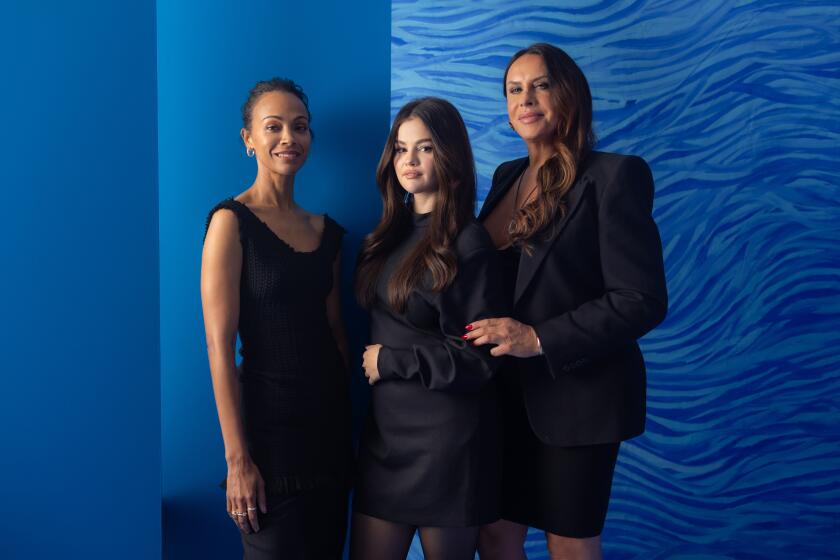Review: The films of Ukraine’s Sergei Loznitsa invite a closer look at history
Few people know how to navigate a crowd quite like Sergei Loznitsa. Whether he’s using a carefully positioned tripod or thrusting his handheld camera directly into the fray, the Belarus-born Ukrainian director has an unusually sharp, patient eye for swarming human multitudes, their physical configurations and patterns of movement. Stories may require faces, these movies seem to be saying, but they don’t always require close-ups.
Since making his 1996 filmmaking debut with the short documentary “Today We Are Going to Build a House,” Loznitsa, now 52, has often turned his steady, exacting gaze on strange places and complicated histories. While most of his work has been nonfiction, he is best known for two exquisitely bleak Russian-set narratives, the contemporary thriller “My Joy” (2010) and the World War II drama “In the Fog” (2012), which both screened at the Cannes Film Festival and firmly established his reputation abroad.
Neither “My Joy” nor “In the Fog” is among the seven Loznitsa-directed documentaries being presented this week by Los Angeles Filmforum, offering a rare big-screen opportunity to appreciate the skillful obliqueness of the director’s method. Whatever his subject may be with any given project — the nature of political revolt, or the challenge of historical remembrance — Loznitsa’s approach is invariably one of sly indirection and implicit moral inquiry. His mostly black-and-white images are beautiful to behold, but they are also rife with the kind of understated, provocative ideas that demand an active viewer.
The lone color-shot work here is “Maidan” (2014), a gripping cinematic anatomy of the revolution that took place in Kiev, Ukraine, in late 2013 and early 2014. Bracing yet meticulously distanced, the film presents shot after deliberately framed shot of protesters gathered in enormous throngs in the city’s Independence Square (known locally as Maidan Nezalezhnosti). Sometimes they stand about listening, chanting, cooking, singing and praying; sometimes they seem to move as one teeming, agitated mass, fleeing gas bombs and clashing with riot police.
“Maidan” tells an urgent, timeless story — of a revolution’s thrilling, unified beginning and its tense, chaotic unraveling — but it tells it without editorializing, and indeed with few of the techniques often associated with documentary storytelling. There are no personal narratives or talking heads, and none of the graphic devices typically employed to break things up visually. Loznitsa has little interest in breaking things up. He doesn’t just record the world with his camera; he creates it, in images whose richness of quotidian detail slowly but inexorably pull you in.
The short works screening in the series include “The Train Station” (2000) and “The Letter” (2012), both of which unfold in narration-free silence and find a disturbing strangeness in their secluded Russian locations (a train depot and a makeshift mental asylum, respectively). Something similar could be said of “The Old Jewish Cemetery” (2014), which spends 20 minutes quietly observing people wandering about a mass burial site in Riga, Latvia, lingering in the gap between its present-day calm and its unspeakably tragic history.
Loznitsa delivers a masterful elaboration of that same theme in his most recent work, “Austerlitz,” which first premiered at last year’s Venice and Toronto film festivals. A 94-minute immersion in the daily activities at what was once Sachsenhausen concentration camp in Germany, this eerily brilliant documentary might be described as people-watching at its most perverse. By inviting us to consider the ghastly scourge of Holocaust tourism, in which visitors take smiling selfies in front of what used to be the gates of hell, Loznitsa interrogates the very purpose of remembrance, asking whether “Never forget,” in this instance, might be better replaced with “Never mind.”
“Austerlitz” would be a must-see even if the Trump administration hadn’t so recently reminded us of the importance of respectful commemoration of the Holocaust. American viewers could doubtless learn something too from the political protests recorded in Loznitsa’s “The Event” (2015), which consists entirely of footage shot in St. Petersburg in August 1991 during a failed attempt by communists to topple the regime of Mikhail Gorbachev and Boris Yeltsen.
Like the series’ other found-footage work, “Blockade” (2005), a haunting hour-long look at the siege of Leningrad during World War II, “The Event” is roughly assembled but deeply immersive, a work of continual visual and historical fascination. Its swirl of images, captured by eight different camera operators, makes for a more propulsive viewing experience than the director’s other efforts, with their more fixed perspectives.
But don’t let the formal differences fool you. One of the invaluable lessons of Loznitsa’s work is that even an immobile spectator can bear striking witness to the beauty and ugliness of history in motion.
------------
‘The Films of Sergei Loznitsa’
“The Train Station,” “The Letter,” “Blockade” (with Loznitsa in attendance)
When: 7:30 p.m. Saturday
Where: Spielberg Theatre at the Egyptian, Hollywood
Price: $10, free for Los Angeles Filmforum members
“The Old Jewish Cemetery,” “Austerlitz” (with Loznitsa in attendance)
When: 7:30 p.m. Monday
Where: James Bridges Theater, UCLA School of Theater, Film and Television
Price: Free
“Maidan” (with Loznitsa in attendance)
When: 7 p.m. Tuesday
Where: Cal Arts Bijou Theatre, Valencia
Price: Free
“The Event” (with Loznitsa in attendance)
When: 7:30 p.m. Wednesday
Where: Cinefamily, Los Angeles
Price: $14
See the most-read stories in Entertainment this hour »
Movie Trailers
More to Read
Only good movies
Get the Indie Focus newsletter, Mark Olsen's weekly guide to the world of cinema.
You may occasionally receive promotional content from the Los Angeles Times.











